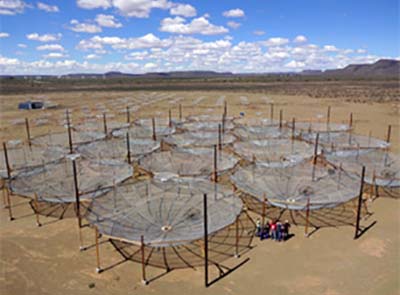The Hydrogen Epoch of Reionisation Array (HERA) was granted the status of SKA precursor telescope by SKA Organisation, joining the three other SKA precursor telescopes located on the SKA sites in Australia and South Africa.
“We’re very pleased to grant HERA the status of SKA precursor,” says Professor Philip Diamond, SKA director-general. “HERA is an impressive telescope in its own right that will provide us with valuable input both scientifically and technologically in the design of the SKA.”
Precursors are telescopes that carry out SKA-related technology and science and whose teams exchange regularly with the SKA design teams. The status of precursor is only granted to facilities at the SKA sites, while the status of pathfinder applies to facilities anywhere in the world.
Under construction at the SKA South African site, HERA will consist of an array of up to 350 14-metre diameter parabolas studying the Universe between 50MHz to 250MHz. As such HERA will be a precursor of SKA-low, the low frequency part of the SKA, to be built in Australia from 2018 onwards.
HERA is an experiment focused on one science goal – detecting the Epoch of Reionisation signal – and is not a general facility. As part of this effort, HERA is developing techniques, algorithms, calibration and processing pipelines and hardware optimized towards the detection of the power spectrum of the EOR, all of which will benefit SKA in designing and using SKA-low.
“The HERA partners are looking forward to closer links to the SKA project on low frequency techniques and science,” says David DeBoer, HERA project manager and from the University of Berkeley. “We hope to contribute to the global effort to achieve a deep understanding of these cosmic ‘formative years’.”
HERA is a project of the American National Science Foundation (NSF) in partnership with an international consortium of universities, including Arizona State University, Brown University, University of California, University of Pennsylvania, University of Washington, Massachusetts Institute of Technology and National Radio Astronomy Observatory in the USA, as well as University of Cambridge in the UK, Scuola Normale Superiore di Pisa in Italy and SKA-South Africa in South Africa.
MeerKAT, currently under construction in South Africa, the Australian SKA Pathfinder (ASKAP), undergoing commissioning in Australia, and the Murchison Widefield Array (MWA) telescope, operating since 2013 and currently being extended, are the three other SKA precursor telescopes. The SKA will now benefit from two precursor facilities at each site, covering both low- and mid-frequencies.
Precursor telescopes provide SKA scientists with invaluable knowledge to assist in the design of the SKA’s main telescopes over the coming decade.
Located at future SKA sites, these precursors are and will be in future carrying out scientific study related to future SKA activities, as well as helping the development and testing of new crucial SKA technologies.
To be classified as a precursor, the instrument has to prove that it contains new technical elements that have not been tried before on the scale of a large telescope and which are part of the SKA Baseline Design (technology); that it will carry out observational tests, both simulated and real, that explore new capabilities at flux density and dynamic range levels similar to or scalable to the full SKA (science); and that it tests methods of scheduling and allocating time similar, or scalable to, that needed for the SKA (operation).
Pictured: The HERA elements on the SKA SA site outside Carnarvon in the Northern Cape.

